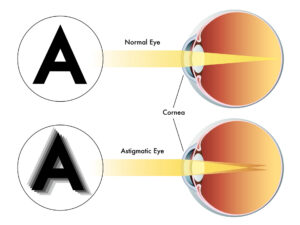Astigmatism occurs when the curvature of the eye’s cornea is warped, causing the patient’s vision to blur as a result.
A normal eye shape should be round and spherical, like a ping pong ball. However, those with astigmatism have oval-shaped eyes that tend to resemble an egg or a rugby ball. There are two ways the cornea can develop improperly to cause astigmatism:
- Horizontally, wherein the eyeball is wider than it is tall
- Vertically, wherein the eyeball is taller than it is wide
Whether a person has horizontal or vertical astigmatism, they will experience blurriness up close and far away because of refraction issues caused by the misshapen cornea.
In many cases, one eye can exhibit a differing level of astigmatism from the other eye, causing them to need two contact prescriptions or eyeglasses with lenses of two different prescriptions.

When Can Astigmatism Develop?
Astigmatism is usually hereditary and can affect some people as early as birth. However, others may have 20/20 vision in childhood but exhibit signs of astigmatism as they age. In other cases, astigmatism presents as a result of an eye injury or a side effect of surgery.
What Can Cause My Astigmatism to Worsen?
Whether your astigmatism presents from birth onward or develops later in life, it is a condition that can gradually change and worsen over time. Patients with additional refraction issues, eye conditions like keratoconus, or lifelong astigmatism can experience more severe astigmatism as they age.
Additional Refraction Issues
Nearsightedness (myopia), farsightedness (hyperopia), and difficulty seeing items up close (presbyopia) are refractive issues that can occur alongside astigmatism. In most cases, astigmatism and nearsightedness accompany each other since the curvature issues that astigmatism causes usually lead to shorter vision.
Having these refraction issues concurrently with astigmatism can make it seem as if one condition causes the other to worsen. However, refraction issues alone cannot worsen astigmatism or vice versa. Eyes with irregular shapes can stop warping at some point, or they can continue to warp over time and cause your vision to worsen. Genetics greatly impacts whether your vision will level off or continue getting worse as time passes.
Additionally, the longer you have refraction issues, the more likely you are to experience worsening vision over time. Those with astigmatism at birth or who develop it in early childhood are at a greater risk of experiencing more severe astigmatism in adulthood. Those who develop astigmatism later in life are likelier to experience a milder trajectory of worsening vision.
Keratoconus
Keratoconus is an uncommon condition that causes the cornea to stretch thin and protrude forward, further warping the shape of the eye. Keratoconus usually affects both eyes and can develop because of genetics or external circumstances, such as too much eye inflammation due to allergies or too much eye rubbing.
Because keratoconus causes more misshaping of the eye, it can lead to worsening astigmatism, in addition to other vision complications.
Additional symptoms of keratoconus include:
- Light-related glare or halos
- Nighttime vision issues
- Eye pain or headaches that stem from eye pain
- Light sensitivity
- Clouded vision that quickly worsens

How Can I Know if My Astigmatism Has Gotten Worse?
Many patients can tell when their current prescription no longer serves their eyesight. If your vision that was once clear using corrective lenses like eyeglasses or contacts becomes blurry, or if you notice yourself straining your eyes to see even though your corrective lenses are in place, your astigmatism has likely worsened.
A surefire way to tell if you need an updated prescription for worsening astigmatism is through a comprehensive eye exam with a trusted optometrist or ophthalmologist. Your eye doctor will perform a thorough eye exam to examine how your eyesight has developed, analyze the health of your eyes, and determine what new prescription you need to improve your vision.
What to Expect During a Comprehensive Eye Exam
Children and adults benefit from routine eye exams and can expect the following procedures during each appointment:
- Glaucoma evaluation
- Cataract evaluation
- Keratoconus evaluation
- Macular degeneration evaluation
- Refraction test
My Astigmatism Has Remained the Same. Do I Still Need to Schedule Eye Exams?
Yes. Regular eye exams are not just beneficial to monitor your eyesight prescriptions or the progression of your astigmatism; they are also crucial for knowing the state of your eye health. Serious ocular conditions like glaucoma and macular degeneration are slow to develop but cause permanent damage, and warning signs do not appear for either until it’s too late. While it is possible to slow or stop either condition’s progression, it is impossible to reverse any damage already done by glaucoma or macular degeneration.
Eye exams can also inform you of other medical conditions you may be developing, such as:
- Certain cancers
- Diabetes
- Heart disease
- High blood pressure
- High cholesterol
- Thyroid disorder
If it’s time for your next eye exam or you want to speak with an ophthalmologist about your worsening astigmatism, turn to the experts at Vision Eye Group.
Our skilled eye doctors are highly trained in treating your eyes and have years of experience caring for the ocular health of patients throughout Middle Georgia. Patients with astigmatism can rely on our practice to monitor the condition of their eyesight and provide updated prescriptions for clearer vision whenever necessary. Our doctors will also evaluate your eye health and take action for your ocular health whenever necessary. Schedule an appointment with Vision Eye Group today: 478-744-1710
